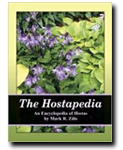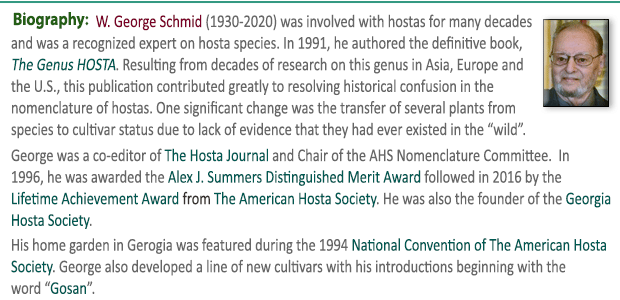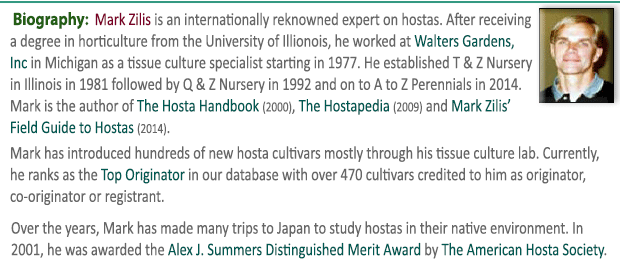|
 This species was found on Honshu
Island in Japan. It forms an
upright growing,
large size (22 inches high by 42 inches wide) mound
of shiny, dark foliage. Pale purple flowers with whitish petal
margins appear in late July. Blooms are borne
on purple dotted pedicels. It is a natural
triploid and is sterile so the plants propagate vegetatively by rhizomes. This species was found on Honshu
Island in Japan. It forms an
upright growing,
large size (22 inches high by 42 inches wide) mound
of shiny, dark foliage. Pale purple flowers with whitish petal
margins appear in late July. Blooms are borne
on purple dotted pedicels. It is a natural
triploid and is sterile so the plants propagate vegetatively by rhizomes.
  This
species of Hosta is generally found growing in marshes
and bogs.
The Genus Hosta by W. George Schmid (1991), did not find any of this species
being cultivated in Western gardens. This
species of Hosta is generally found growing in marshes
and bogs.
The Genus Hosta by W. George Schmid (1991), did not find any of this species
being cultivated in Western gardens.
Perhaps the most identifiable trait of
H. alismifolia is that the flower parts are a homogeneous light purple
with no stripes and it has purple anthers.
The Hosta Handbook by Mark Zilis (2000),
observes that this species "...is a fairly obscure Japanese
species found in only a few American collections, it deserves
more attention. The shiny, dark green foliage and upright mound
habit make it an ornamentally superior plant."
 According to
The Hostapedia by Mark Zilis (2009), "The shiny, dark green foliage of
this rare species makes it an ornamental asset in the shade
garden. I observed it growing in deciduous forests and among
grasses (at high elevation) on Honshu Island in
Japan." According to
The Hostapedia by Mark Zilis (2009), "The shiny, dark green foliage of
this rare species makes it an ornamental asset in the shade
garden. I observed it growing in deciduous forests and among
grasses (at high elevation) on Honshu Island in
Japan."
Mark Zilis' Field Guide to Hostas
(2014) states that this
species was found in Japan in "...edge of woods;
wetlands...listed as sterile by som sources...but
shows evidence of fertility based upon existing
forms and known seedlings in the United States and
Japan."

 An article by
Hajime Sugata of Japan in
The
Hosta Journal (1994 Vol. 25 No. 2) says that "H.
alismifolia is a little-known hosta not
found in the Botanical Encyclopedia. I
confirm that it grows at Tsukude Villiage,
Minamishitara County; Nukata Town, Nukata County;
and Shimoyama Village, Higashikamo County in Aichi
Pref.; and Toki City, Kani City, and Sakahogi Town
in Gifu Pref. An article by
Hajime Sugata of Japan in
The
Hosta Journal (1994 Vol. 25 No. 2) says that "H.
alismifolia is a little-known hosta not
found in the Botanical Encyclopedia. I
confirm that it grows at Tsukude Villiage,
Minamishitara County; Nukata Town, Nukata County;
and Shimoyama Village, Higashikamo County in Aichi
Pref.; and Toki City, Kani City, and Sakahogi Town
in Gifu Pref.
"...My observations of many different forms of H.
alismifolia leads to the conclusion that is a
randomly appearing sport. H. alismifolia is
found in wetlands, along rice paddies, or near
streams. It always coexists with
H. longissima,
H. montana,
and H. albo-marginata (H.sieboldii).
Interestingly enough it is never found without H.
longissima nearby. It usually forms a large clump."
 Only a few books mention H. alismifolia and
they contain limited information. One of them states
that it does not set seed. However, I have
hybridized many plants...I have succeeded in
producing several plants that set viable seeds." Only a few books mention H. alismifolia and
they contain limited information. One of them states
that it does not set seed. However, I have
hybridized many plants...I have succeeded in
producing several plants that set viable seeds."
 The Latin name alismifolia can be loosely translated as "Alisma-leaved".
Alsima is a genus that contains several species including
the one shown to the right,
Alisma plantago-aquatica whose leaves generally resemble those
of this hosta species. The Latin name alismifolia can be loosely translated as "Alisma-leaved".
Alsima is a genus that contains several species including
the one shown to the right,
Alisma plantago-aquatica whose leaves generally resemble those
of this hosta species.





 |



